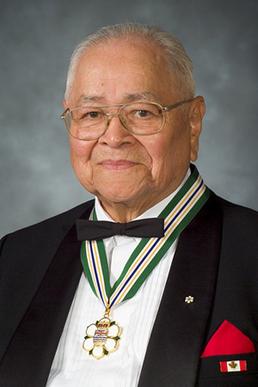Frank Calder (politician) facts for kids
Quick facts for kids
Frank Arthur Calder
OC OBC
|
|
|---|---|

2004 Order of British Columbia
|
|
| Member of the British Columbia Legislative Assembly for Atlin |
|
| In office June 15, 1949 – May 10, 1979 |
|
| Preceded by | William Duncan Smith |
| Succeeded by | Al Passarell |
| Personal details | |
| Born | August 3, 1915 Nass Harbour, British Columbia |
| Died | November 4, 2006 (aged 91) Victoria, British Columbia |
| Political party | Social Credit (1974-1979) New Democrat (1949-1974) |
| Spouse | Tamaki Koshibe |
Frank Arthur Calder (August 3, 1915 – November 4, 2006) was an important Nisga'a politician in Canada. He was a strong voice for Indigenous rights.
Frank Calder was born in Nass Harbour, British Columbia. He was the first Indigenous person to graduate from the Anglican Theological College. This college is part of the University of British Columbia. Mr. Calder was also a hereditary chief from the Killerwhale Tribe. He passed away in Victoria in 2006.
Contents
Frank Arthur Calder: A Leader for Indigenous Rights
Early Life and Education
Frank Arthur Calder was born on August 3, 1915. His birthplace was Nass Harbour in British Columbia. He achieved a significant milestone in his education. He was the first Indigenous person to graduate from the Anglican Theological College. This college is part of the University of British Columbia. He was also a hereditary chief. This means he inherited a leadership role in his community. He belonged to the House of Wisinxbiltkw from the Killerwhale Tribe.
A Career in Politics
Frank Calder began his political journey in 1949. He was elected to the Legislative Assembly of British Columbia. This is like being a member of parliament for the province. He represented the area called Atlin. He served in this role for many years, until 1979. Calder was part of the Co-operative Commonwealth Federation party. This party later became known as the New Democratic Party.
First Indigenous Cabinet Minister
In 1972, Frank Calder made history. He was appointed to the cabinet in Dave Barrett's government. This made him British Columbia's first Indigenous cabinet minister. A cabinet minister is a senior government official. They are in charge of a specific department. In 1973, he left his cabinet position after a personal incident. In 1974, he tried to be re-elected as president of the Nisga'a Tribal Council. However, he was defeated by Joseph Gosnell.
In 1975, Calder changed political parties. He joined the Social Credit Party of British Columbia. He was re-elected to his seat. However, in 1979, he lost his seat by just one vote. The winner was Al Passarell from the New Democratic Party.
Fighting for Indigenous Land Rights
Frank Calder is well-known for a very important court case. It was called "Calder vs. Attorney General of British Columbia". This case was argued by Thomas R. Berger. Calder took this case all the way to the Supreme Court of Canada.
The Landmark Calder Case
Through this case, Frank Calder proved something very important. He showed that Aboriginal title still exists in Canadian law. Aboriginal title means that Indigenous peoples have rights to their traditional lands. This court decision was a huge step forward. It had a big impact across Canada and even internationally. This decision also became the foundation for the Nisga'a treaty.
Impact on Canadian Law
Before the Calder Case, there was no clear way to settle land claims in Canada. Land claims are when Indigenous groups ask for their traditional lands back. The Calder case helped to clarify which lands could be negotiated. After this case, Canada created a new policy. This policy helps guide negotiations for land claims. Frank Calder continued to fight for the Nisga'a's treaty rights. He worked on this as recently as the year 2000.
Calder also started the Nisga'a Tribal Council. This was the first tribal council created in British Columbia. He was the president of this council for 21 years. He served until 1974.
Awards and Recognition
Frank Calder received many important awards for his work.
- In 1987, he was made an Officer of the Order of Canada. This is one of Canada's highest honors.
- He was also given the Aboriginal Order of Canada.
- In 1996, he received the National Aboriginal Achievement Award.
- In 2004, he was awarded the Order of British Columbia. This is the highest honor in his home province.

